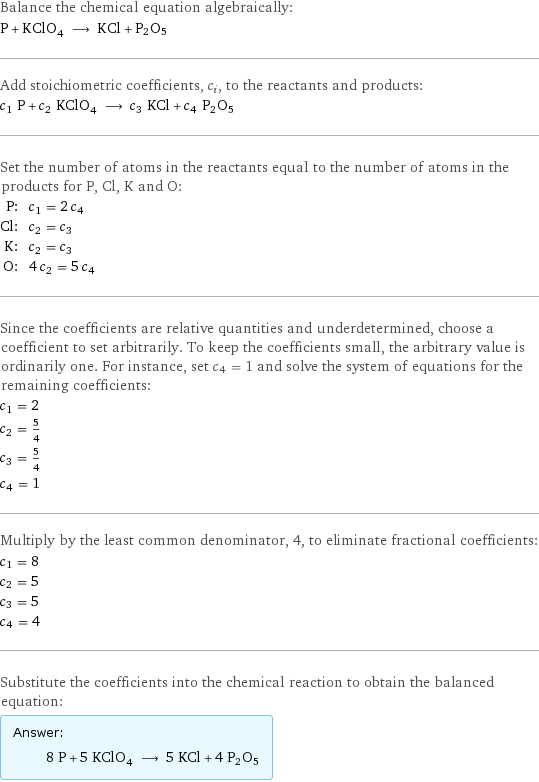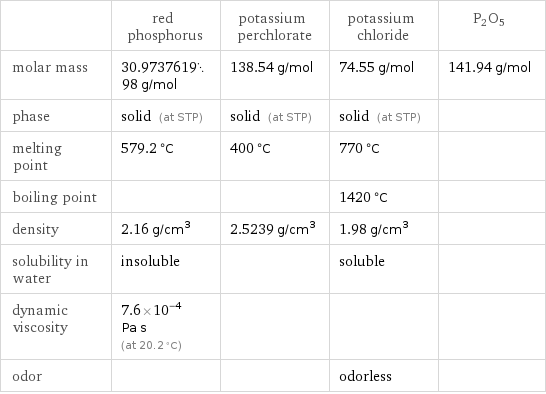Input interpretation

P red phosphorus + KClO_4 potassium perchlorate ⟶ KCl potassium chloride + P2O5
Balanced equation

Balance the chemical equation algebraically: P + KClO_4 ⟶ KCl + P2O5 Add stoichiometric coefficients, c_i, to the reactants and products: c_1 P + c_2 KClO_4 ⟶ c_3 KCl + c_4 P2O5 Set the number of atoms in the reactants equal to the number of atoms in the products for P, Cl, K and O: P: | c_1 = 2 c_4 Cl: | c_2 = c_3 K: | c_2 = c_3 O: | 4 c_2 = 5 c_4 Since the coefficients are relative quantities and underdetermined, choose a coefficient to set arbitrarily. To keep the coefficients small, the arbitrary value is ordinarily one. For instance, set c_4 = 1 and solve the system of equations for the remaining coefficients: c_1 = 2 c_2 = 5/4 c_3 = 5/4 c_4 = 1 Multiply by the least common denominator, 4, to eliminate fractional coefficients: c_1 = 8 c_2 = 5 c_3 = 5 c_4 = 4 Substitute the coefficients into the chemical reaction to obtain the balanced equation: Answer: | | 8 P + 5 KClO_4 ⟶ 5 KCl + 4 P2O5
Structures

+ ⟶ + P2O5
Names

red phosphorus + potassium perchlorate ⟶ potassium chloride + P2O5
Equilibrium constant
![Construct the equilibrium constant, K, expression for: P + KClO_4 ⟶ KCl + P2O5 Plan: • Balance the chemical equation. • Determine the stoichiometric numbers. • Assemble the activity expression for each chemical species. • Use the activity expressions to build the equilibrium constant expression. Write the balanced chemical equation: 8 P + 5 KClO_4 ⟶ 5 KCl + 4 P2O5 Assign stoichiometric numbers, ν_i, using the stoichiometric coefficients, c_i, from the balanced chemical equation in the following manner: ν_i = -c_i for reactants and ν_i = c_i for products: chemical species | c_i | ν_i P | 8 | -8 KClO_4 | 5 | -5 KCl | 5 | 5 P2O5 | 4 | 4 Assemble the activity expressions accounting for the state of matter and ν_i: chemical species | c_i | ν_i | activity expression P | 8 | -8 | ([P])^(-8) KClO_4 | 5 | -5 | ([KClO4])^(-5) KCl | 5 | 5 | ([KCl])^5 P2O5 | 4 | 4 | ([P2O5])^4 The equilibrium constant symbol in the concentration basis is: K_c Mulitply the activity expressions to arrive at the K_c expression: Answer: | | K_c = ([P])^(-8) ([KClO4])^(-5) ([KCl])^5 ([P2O5])^4 = (([KCl])^5 ([P2O5])^4)/(([P])^8 ([KClO4])^5)](../image_source/7ef8ab8a8097585dffdf73a5cfce084a.png)
Construct the equilibrium constant, K, expression for: P + KClO_4 ⟶ KCl + P2O5 Plan: • Balance the chemical equation. • Determine the stoichiometric numbers. • Assemble the activity expression for each chemical species. • Use the activity expressions to build the equilibrium constant expression. Write the balanced chemical equation: 8 P + 5 KClO_4 ⟶ 5 KCl + 4 P2O5 Assign stoichiometric numbers, ν_i, using the stoichiometric coefficients, c_i, from the balanced chemical equation in the following manner: ν_i = -c_i for reactants and ν_i = c_i for products: chemical species | c_i | ν_i P | 8 | -8 KClO_4 | 5 | -5 KCl | 5 | 5 P2O5 | 4 | 4 Assemble the activity expressions accounting for the state of matter and ν_i: chemical species | c_i | ν_i | activity expression P | 8 | -8 | ([P])^(-8) KClO_4 | 5 | -5 | ([KClO4])^(-5) KCl | 5 | 5 | ([KCl])^5 P2O5 | 4 | 4 | ([P2O5])^4 The equilibrium constant symbol in the concentration basis is: K_c Mulitply the activity expressions to arrive at the K_c expression: Answer: | | K_c = ([P])^(-8) ([KClO4])^(-5) ([KCl])^5 ([P2O5])^4 = (([KCl])^5 ([P2O5])^4)/(([P])^8 ([KClO4])^5)
Rate of reaction
![Construct the rate of reaction expression for: P + KClO_4 ⟶ KCl + P2O5 Plan: • Balance the chemical equation. • Determine the stoichiometric numbers. • Assemble the rate term for each chemical species. • Write the rate of reaction expression. Write the balanced chemical equation: 8 P + 5 KClO_4 ⟶ 5 KCl + 4 P2O5 Assign stoichiometric numbers, ν_i, using the stoichiometric coefficients, c_i, from the balanced chemical equation in the following manner: ν_i = -c_i for reactants and ν_i = c_i for products: chemical species | c_i | ν_i P | 8 | -8 KClO_4 | 5 | -5 KCl | 5 | 5 P2O5 | 4 | 4 The rate term for each chemical species, B_i, is 1/ν_i(Δ[B_i])/(Δt) where [B_i] is the amount concentration and t is time: chemical species | c_i | ν_i | rate term P | 8 | -8 | -1/8 (Δ[P])/(Δt) KClO_4 | 5 | -5 | -1/5 (Δ[KClO4])/(Δt) KCl | 5 | 5 | 1/5 (Δ[KCl])/(Δt) P2O5 | 4 | 4 | 1/4 (Δ[P2O5])/(Δt) (for infinitesimal rate of change, replace Δ with d) Set the rate terms equal to each other to arrive at the rate expression: Answer: | | rate = -1/8 (Δ[P])/(Δt) = -1/5 (Δ[KClO4])/(Δt) = 1/5 (Δ[KCl])/(Δt) = 1/4 (Δ[P2O5])/(Δt) (assuming constant volume and no accumulation of intermediates or side products)](../image_source/0e1b1d739d3db321cbcd31582ddf6989.png)
Construct the rate of reaction expression for: P + KClO_4 ⟶ KCl + P2O5 Plan: • Balance the chemical equation. • Determine the stoichiometric numbers. • Assemble the rate term for each chemical species. • Write the rate of reaction expression. Write the balanced chemical equation: 8 P + 5 KClO_4 ⟶ 5 KCl + 4 P2O5 Assign stoichiometric numbers, ν_i, using the stoichiometric coefficients, c_i, from the balanced chemical equation in the following manner: ν_i = -c_i for reactants and ν_i = c_i for products: chemical species | c_i | ν_i P | 8 | -8 KClO_4 | 5 | -5 KCl | 5 | 5 P2O5 | 4 | 4 The rate term for each chemical species, B_i, is 1/ν_i(Δ[B_i])/(Δt) where [B_i] is the amount concentration and t is time: chemical species | c_i | ν_i | rate term P | 8 | -8 | -1/8 (Δ[P])/(Δt) KClO_4 | 5 | -5 | -1/5 (Δ[KClO4])/(Δt) KCl | 5 | 5 | 1/5 (Δ[KCl])/(Δt) P2O5 | 4 | 4 | 1/4 (Δ[P2O5])/(Δt) (for infinitesimal rate of change, replace Δ with d) Set the rate terms equal to each other to arrive at the rate expression: Answer: | | rate = -1/8 (Δ[P])/(Δt) = -1/5 (Δ[KClO4])/(Δt) = 1/5 (Δ[KCl])/(Δt) = 1/4 (Δ[P2O5])/(Δt) (assuming constant volume and no accumulation of intermediates or side products)
Chemical names and formulas

| red phosphorus | potassium perchlorate | potassium chloride | P2O5 formula | P | KClO_4 | KCl | P2O5 Hill formula | P | ClKO_4 | ClK | O5P2 name | red phosphorus | potassium perchlorate | potassium chloride | IUPAC name | phosphorus | potassium perchlorate | potassium chloride |
Substance properties

| red phosphorus | potassium perchlorate | potassium chloride | P2O5 molar mass | 30.973761998 g/mol | 138.54 g/mol | 74.55 g/mol | 141.94 g/mol phase | solid (at STP) | solid (at STP) | solid (at STP) | melting point | 579.2 °C | 400 °C | 770 °C | boiling point | | | 1420 °C | density | 2.16 g/cm^3 | 2.5239 g/cm^3 | 1.98 g/cm^3 | solubility in water | insoluble | | soluble | dynamic viscosity | 7.6×10^-4 Pa s (at 20.2 °C) | | | odor | | | odorless |
Units
